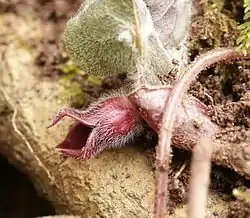Asarum
Asarum is a genus of plants in the birthwort family Aristolochiaceae, commonly known as wild ginger.
| Asarum | |
|---|---|
 | |
| Asarum caudatum (western wild ginger) | |
| Scientific classification | |
| Kingdom: | Plantae |
| Clade: | Tracheophytes |
| Clade: | Angiosperms |
| Clade: | Magnoliids |
| Order: | Piperales |
| Family: | Aristolochiaceae |
| Subfamily: | Asaroideae |
| Genus: | Asarum L. |
| Type species | |
| Asarum europaeum | |
| Species | |
|
See text | |
Asarum is the genitive plural of the Latin āsa (an alternate form of āra) meaning altar or sanctuary.
Description
Asarum is a genus of low-growing herbs distributed across the temperate zones of the Northern Hemisphere, with most species in East Asia (China, Japan, and Vietnam) and North America, and one species in Europe. Biogeographically, Asarum originated in Asia.
They have characteristic kidney-shaped leaves, growing from creeping rhizomes, and bear small, axillary, brown or reddish flowers.
The plant is called wild ginger because the rhizome tastes and smells similar to ginger root, but the two are not particularly related. The FDA warns against consuming Asarum, as it is nephrotoxic and contains the potent carcinogen aristolochic acid.[1][2] [3] The birthwort family also contains the genus Aristolochia, known for carcinogens.
Wild ginger favors moist, shaded sites with humus-rich soil. The deciduous, heart-shaped leaves are opposite, and borne from the rhizome which lies just under the soil surface. Two leaves emerge each year from the growing tip. The curious jug-shaped flowers, which give the plant an alternate name, little jug, are borne singly in spring between the leaf bases.
Wild ginger can easily be grown in a shade garden, and makes an attractive groundcover.

Taxonomy
Traditionally, the genus Asarum was considered as a single genus with about 85 species. However, a trend exists among some botanists to segregate the genus into separate genera, based on considerations of chromosome number and floral morphology:
- Asarum sensu stricto (about 17 species), distributed in Asia (mainly China), North America, and Europe
- Heterotropa (about 50 species), distributed in Asia
- Asiasarum (three or four species), distributed in Asia
- Geotaenium (three or four species), distributed in Asia
- Hexastylis (ten species), distributed in North America
Study of the internal transcribed spacer region (ITS) of nuclear ribosomal DNA, combined with morphological data, has yielded a better-resolved phylogenetic hypothesis, supporting a recognition of two subgenera, Asarum and Heterotropa each containing two sections, rather than the segregated genera above.[4]
- Asarum sensu stricto (s.s.) : the North American species are monophyletic and are derived from within the paraphyletic Asian species group.
- Geotaenium is a sister to Asarum s.s., showing its close relationship to Asarum s.s..
- Asiasarum is a sister to the Hexastylis + Heterotropa clade, showing several synapomorphies with this clade.
- Hexastylis: this genus has been recognized solely on the study by H.L. Blomquist.[5] However, the above-mentioned DNA study provided indications that Hexastylis is not monophyletic and that some species of Hexastylis are more closely related to Asiatic species of Heterotropa than they are to other species of Hexastylis.
- Heterotropa: this is a complex monophyletic group, well nested within the Asiasarum + Hexastylis + Heterotropa clade
Therefore, many botanists still treat these segregated genera as subgenera and sections of Asarum sensu lato, especially Hexastylis.[6]
Species
- Asarum arifolium
- Asarum asperum
- Asarum bashanense
- Asarum campaniflorum
- Asarum canadense
- Asarum caudatum
- Asarum caudigerellum
- Asarum caudigerum
- Asarum caulescens
- Asarum chengkouense
- Asarum chinensis
- Asarum controversum
- Asarum crassisepalum
- Asarum crassum
- Asarum crispulatum
- Asarum debile
- Asarum delavayi
- Asarum dimidiatum (synonym of Asiasarum dimidiatum)
- Asarum epigynum (synonym of Geotaenium epigynum)
- Asarum europaeum
- Asarum forbesii (synonym of Heterotropa forbesii)
- Asarum fukienense
- Asarum geophilum (synonym of Geotaenium geophilum)
- Asarum gusuk
- Asarum hartwegii
- Asarum hayatanum
- Asarum heterotropioides (synonym of Asiasarum heterotropiodes)
- Asarum himalaicum
- Asarum hongkongense
- Asarum hypogynum
- Asarum ichangense
- Asarum inflatum
- Asarum insignis
- Asarum kooyanum
- Asarum lemmonii
- Asarum leptophyllum
- Asarum longerhizomatosum
- Asarum macranthum
- Asarum magnificum
- Asarum majale
- Asarum marmoratum
- Asarum maruyamae
- Asarum maximum
- Asarum mikuniense
- Asarum mitoanum
- Asarum nanchuanense
- Asarum nobilissimum
- Asarum petelotii
- Asarum porphyronotum
- Asarum pulchellum
- Asarum renicordatum
- Asarum sagittarioides
- Asarum senkakuinsulare
- Asarum sieboldii (synonym of Asiasarum sieboldii)
- Asarum splendens
- Asarum taipingshanianum
- Asarum tohokuense
- Asarum tongjiangense
- Asarum wagneri
- Asarum wulingense
- Asarum yunnanense (synonym of Geotaenium yunnanse)
References
- Schaneberg BT, Applequist WL, Khan IA (October 2002). "Determination of aristolochic acid I and II in North American species of Asarum and Aristolochia". Pharmazie. 57 (10): 686–9. PMID 12426949.
- "Aristolochic Acid: FDA Warns Consumers to Discontinue Use of Botanical Products that Contain Aristolochic Acid". U.S. Food and Drug Administration. April 11, 2001.
- Health Canada advising not to use products labelled to contain Aristolochia Archived February 16, 2006, at the Wayback Machine.
- Lawrence M. Kelley (1998). "Phylogenetic relationships in Asarum (Aristolochiaceae) based on morphology and ITS sequences". American Journal of Botany. 85 (10): 1454–67. doi:10.2307/2446402. JSTOR 2446402. PMID 21684897.
- H.L. Blomquist (1957). "A revision of Hexastylis of North America". Brittonia. 8 (4): 255–281. doi:10.2307/2804978. JSTOR 2804978. S2CID 34632340.
- "Hexastylis". USDA - GRIN. 2009. Retrieved 2009-06-14.
External links
| Wikispecies has information related to Asarum. |
| Wikimedia Commons has media related to Asarum. |
- Takashi Sugawara (1982). "Taxonomic studies of Asarum sensu lato". Journal of Plant Research. 95 (3): 295–302. doi:10.1007/bf02488540. S2CID 115785096.
- Lawrence M. Kelly (2001). "Taxonomy of Asarum Section Asarum (Aristolochiaceae)". Systematic Botany. 26 (1): 17–53. doi:10.1043/0363-6445-26.1.17 (inactive 2021-01-14).CS1 maint: DOI inactive as of January 2021 (link)
- List of Asarum species
- The International Agency for Research on Cancer.
